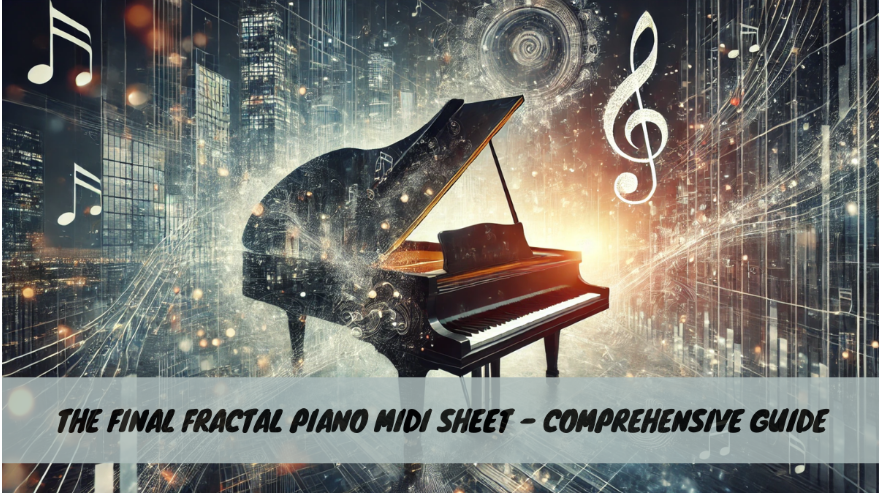The world of piano music is vast ,The Final Fractal Piano MIDI Sheet ranging from classical masterpieces to modern compositions that push the boundaries of sound and technique. One such piece that has captured the imagination of musicians and enthusiasts alike is The Final Fractal. Known for its intricate patterns, complex rhythms, and mesmerizing melody, The Final Fractal offers a unique challenge to pianists, particularly when played using its MIDI sheet.
This article dives into the detailed structure of The Final Fractal Piano MIDI Sheet, exploring what makes it special and how to approach learning and mastering it. Whether you’re a seasoned musician or a beginner fascinated by this piece, you’ll find helpful insights and strategies to enhance your performance.
Understanding the Composition of The Final Fractal
At first glance, the MIDI sheet of The Final Fractal can seem overwhelming. The composition is known for its fractal-like structure, where repetitive patterns build upon each other in increasingly complex ways. As the name suggests, it’s designed to mirror the mathematical beauty of fractals, with each part reflecting a larger, overarching pattern.
The MIDI format, which stands for Musical Instrument Digital Interface, offers an interactive way to study the sheet. Unlike traditional sheet music, MIDI files allow you to listen to the piece, visualize the patterns, and even slow down the tempo to better understand the nuances.
Key Features of The Final Fractal Piano MIDI Sheet
- Complex Patterns: The piece is characterized by repeating sequences, each progressively more elaborate.
- Shifting Time Signatures: One of the challenges pianists face with The Final Fractal is its constantly shifting time signatures, adding an extra layer of difficulty.
- Dynamic Use of Tempo: The MIDI sheet captures the dynamic range of tempo changes, from rapid sections that demand precision to slower, more expressive parts.
Why The Final Fractal Is Considered a Challenge
Playing The Final Fractal on the piano is not for the faint of heart. It demands a high level of technical skill, as well as an ability to interpret the music’s shifting rhythms and dynamics. For many, the greatest challenge lies in maintaining consistency across the repetitive yet increasingly complex patterns.
In MIDI format, this composition becomes more accessible in some ways. The ability to visualize the sheet while listening to the track helps players break down difficult sections into manageable parts. However, this doesn’t take away from the technical proficiency required to perform it live.
The Importance of Finger Placement
Proper finger placement is crucial when playing The Final Fractal. The rapid changes in patterns and the speed at which they must be executed mean that one mistake in fingering can throw off the entire sequence. Studying the MIDI sheet can help pianists map out the most efficient fingerings for each passage.
How to Master The Final Fractal Piano MIDI Sheet
Approaching The Final Fractal requires both patience and strategy. Below are some techniques to help you on your journey:
1. Break It Down Into Sections
Because the piece is built on repetitive patterns, breaking it down into smaller, manageable sections is key. Start by identifying the main motifs and practice them in isolation. Once you’re comfortable with the patterns, gradually increase the speed and complexity by incorporating more of the sheet.
2. Slow Practice with MIDI Playback
One of the benefits of the MIDI sheet is the ability to slow down playback without altering the pitch. This feature is especially helpful for The Final Fractal, where rapid passages can be difficult to hear and comprehend at full speed. Practice with the slowed-down version until you can comfortably play each section before attempting it at tempo.
3. Focus on Rhythmic Precision
As The Final Fractal frequently changes time signatures, maintaining rhythmic accuracy is crucial. Use a metronome to keep time as you practice, and pay close attention to how the rhythm shifts throughout the piece. The MIDI sheet allows you to visually see these changes, which can help improve your timing.
4. Dynamic Expression
Don’t let the technical challenges overshadow the expressive nature of the piece. The Final Fractal is full of dynamic contrasts that require you to balance soft, flowing passages with bold, accented notes. As you practice, make sure to focus on bringing out these dynamic differences, using the MIDI sheet as a guide for where to emphasize changes in volume and intensity.
What Makes MIDI Sheets Valuable for Learning Complex Pieces
MIDI sheets are not just a digital form of traditional sheet music—they offer unique tools that enhance the learning process. For pieces like The Final Fractal, the ability to manipulate playback speed, visualize patterns, and isolate specific sections of the sheet can make all the difference when trying to tackle such a complex composition.
1. Interactive Learning
MIDI sheets allow you to listen to the piece as you follow along, providing an interactive way to engage with the music. This is particularly useful for auditory learners who benefit from hearing the nuances of the piece while studying the sheet.
2. Tempo Control
As mentioned earlier, the ability to slow down difficult passages without changing the pitch is one of the most valuable features of a MIDI sheet. This allows players to focus on accuracy before building up to full speed.
3. Pattern Recognition
The visual format of MIDI sheets makes it easier to spot repetitive patterns, especially in a fractal-based composition like The Final Fractal. By recognizing these patterns early on, players can better anticipate changes and prepare accordingly.
The Final Fractal: A Test of Skill and Precision
There’s no doubt that mastering The Final Fractal is a monumental achievement for any pianist. Its combination of technical complexity and artistic expression makes it a piece that challenges both the mind and the fingers. However, with the help of a MIDI sheet, even this seemingly impossible task becomes more manageable.
For pianists looking to push their limits and explore the boundaries of modern composition, The Final Fractal offers a unique and rewarding experience. Whether you’re using the MIDI sheet to guide your practice or simply enjoying the mathematical beauty of the music, this piece is a true masterpiece of contemporary piano literature.
Tips for Advanced Players Tackling The Final Fractal
While The Final Fractal is certainly a challenge, it’s not beyond the reach of advanced players willing to put in the work. Here are a few additional tips for those already proficient in piano but looking to elevate their performance of this piece:
- Develop Muscle Memory: Given the repetitive nature of the patterns, developing muscle memory will help you play the piece more fluently. Practice each section slowly until the movements become automatic.
- Practice Hands Separately: Isolating the left and right hands is crucial, especially in sections where the two hands are playing vastly different rhythms. By practicing each hand separately, you can focus on mastering the individual patterns before combining them.
- Stay Relaxed: Tension can be a pianist’s worst enemy, especially in fast and complex pieces. Make a conscious effort to stay relaxed, particularly in your hands, arms, and shoulders, as you play.
FAQs
What is the difficulty level of The Final Fractal piano MIDI sheet?
The Final Fractal is considered highly challenging, with complex patterns, shifting time signatures, and fast tempos. It’s suitable for advanced players with strong technical skills.
Can beginners learn The Final Fractal on piano?
While beginners may find this piece overwhelming, breaking it down into smaller sections and using the MIDI sheet to slow down playback can make it more approachable over time.
What makes The Final Fractal unique?
The piece is known for its fractal-like structure, where repetitive patterns build in complexity, mirroring mathematical fractals. This creates a visually and aurally stunning effect.
How can I use the MIDI sheet to improve my practice?
MIDI sheets allow you to control playback speed, isolate difficult sections, and visualize patterns, all of which can help improve accuracy and understanding of the piece.
Is The Final Fractal played at a consistent tempo?
No, the piece features dynamic tempo changes that add to its complexity. The MIDI sheet is helpful in understanding where these changes occur and how to manage them.
What are the key techniques needed to play The Final Fractal?
Some of the key techniques include precise finger placement, rhythmic accuracy, dynamic expression, and the ability to play rapid, repetitive patterns with consistency.
Conclusion
The Final Fractal is a testament to the ever-evolving world of piano music. Its intricate patterns, rhythmic complexity, and dynamic expression make it a rewarding challenge for pianists looking to push their boundaries. The MIDI sheet, with its interactive features, offers an invaluable tool to help players navigate this demanding piece. With patience, practice, and a strategic approach, mastering The Final Fractal is an achievable goal that brings immense satisfaction to those who take on the challenge.











